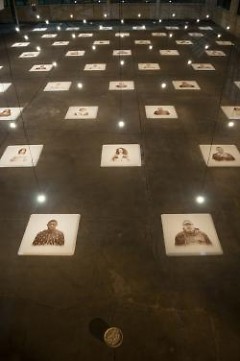Young Kim’s entry in ArtPrize 2009, Salt and Earth, has been swept away, but for many the message and memory of his work will remain. Created solely for the contest, the site-specific piece consisted of fifty squares measuring three feet by three feet made of granular salt with photographs screened onto the salt in clay (earth). Over each square hung a single light bulb that pulsated ever so slightly throughout the day. Along two edges of the work, were bowls filled with various materials: clay or dirt, others had rotting undeterminable fruits, one even had the tips of matchsticks. These bowls represented the four elements of fire, water, air and earth. Upon viewing this piece I experienced an almost spiritual moment and could not help but want to learn more about it.
Kim’s piece was found for the duration of the ArtPrize contest at 47 Commerce. In this case, the venue was almost as important as the work itself. The single-story office building has a post industrial floor plan with enormous windows that added to the atmosphere of the work. They let in abundant light during the day and glowed with the lights from inside in the evening. With such a historic feeling, the building fit right in with the vibe as well. Being right off from Fulton Street, one would think that the central location would have been a help to the artist but with construction right across the street on the future condo/retail high-rise as well as a completely torn up Weston Street, it was easy for the public to miss. Luckily for Kim, word spread quickly about this introspective piece.
Many people ventured through the construction to find 47 Commerce and glimpse this eye-catching success. So smooth were the squares of salt that they looked like cement or concrete blocks. Upon further inspection, one quickly realized that these squares were much more delicate than that. Some salt squares were already disturbed by running children, an accidental jostle from a foot, a person who just couldn’t believe that those were loose grains of salt and had to touch, or even a strong gust of wind from the open door. The squares were laid out in a checkerboard pattern on the floor, beginning with clean, straight lines from the edges of the squares. As the days went on and squares were disturbed, the lines became distorted. This changing nature of the line might represent how humanity likes to put life in a neat, organized box, but as time goes by, life has a way of becoming messy. The distorting, deteriorating nature of the salt could represent the fragility of the human condition.
Each person represented on the salt was photographed through chance encounters within the city of Grand Rapids. Local faces were screened onto the salt with red clay, also local to the area. The use of clay could have represented the fleeting nature of humanity; we are symbolically made from the earth and we return to earth when we die. Eyes are considered the windows to the soul, but none of the people displayed on the salt had their eyes open. Again, this aspect may refer to the mortality of humanity. It also leaves the person anonymous. In this way, each person represented humanity rather than one individual.
To further the point, many different races, ages, and sexes were depicted. The choice to use local clay and photographing local people connected the work to the people of Grand Rapids specifically, hitting a little closer to home. Kim chose not to add multiple colors of dirt to the piece. The lack of color added to the anonymity of the people. No color also lends to the crisp, stark nature of the work that melded and transformed as the squares were slowly destroyed into an amalgamated mess. The sepia toned clay also coordinated with the colors picked up in the building’s design.
In writing about Salt and Earth, I’ve only scratched the surface of what the artist might have been trying to get across. It is clear that this piece had themes of mortality, the fleeting nature of humanity, and nature in general, all while still managing to be aesthetically pleasing. In this writer’s opinion, while up against some other extremely well put together works of art, Young Kim should have won first place in ArtPrize. The location of the venue (however perfect for his work) seemed to work against him. However, it was pleasing to see Kim awarded a Curator’s Choice Award for eleventh place. One can only hope to see similar works by Kim, even if they are destined to be swept away after just a few short weeks.
The Rapidian, a program of the 501(c)3 nonprofit Community Media Center, relies on the community’s support to help cover the cost of training reporters and publishing content.
We need your help.
If each of our readers and content creators who values this community platform help support its creation and maintenance, The Rapidian can continue to educate and facilitate a conversation around issues for years to come.
Please support The Rapidian and make a contribution today.
